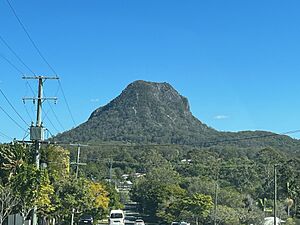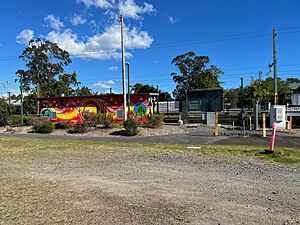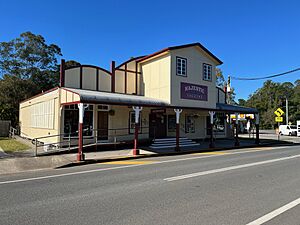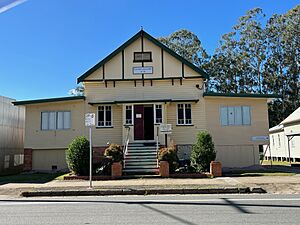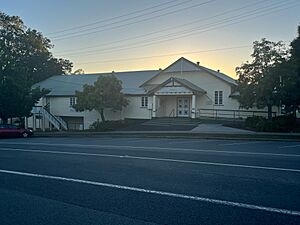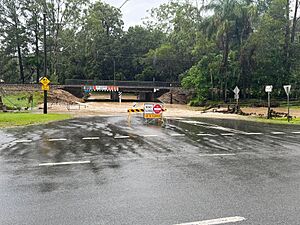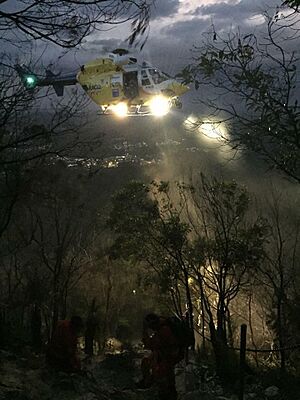Pomona, Queensland facts for kids
Quick facts for kids PomonaSunshine Coast, Queensland |
|||||||||||||||
|---|---|---|---|---|---|---|---|---|---|---|---|---|---|---|---|
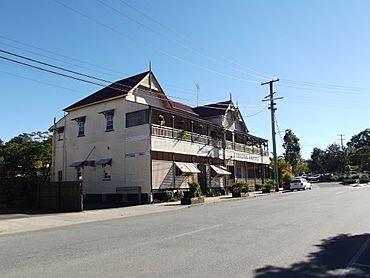
Pomona Hotel in 2012
|
|||||||||||||||
| Population | 2,931 (2021 census) | ||||||||||||||
| • Density | 54.48/km2 (141.1/sq mi) | ||||||||||||||
| Established | 1890 | ||||||||||||||
| Postcode(s) | 4568 | ||||||||||||||
| Area | 53.8 km2 (20.8 sq mi) | ||||||||||||||
| Time zone | AEST (UTC+10:00) | ||||||||||||||
| Location | |||||||||||||||
| LGA(s) | Shire of Noosa | ||||||||||||||
| State electorate(s) |
|
||||||||||||||
| Federal Division(s) | Wide Bay | ||||||||||||||
|
|||||||||||||||
Pomona is a small town located in Queensland, Australia, about 135 kilometers north of Brisbane. It's part of the Shire of Noosa. The town was first known as Pinbarren Siding between 1890 and 1900. In 2021, about 2,931 people lived in Pomona.
Contents
Exploring Pomona's Landscape
Pomona is surrounded by small farms and homes with lots of land. A big part of the area is covered by Yurol State Forest. This forest used to be important for logging, but now it's a protected home for koalas.
Mount Cooroora: A Natural Landmark
Mount Cooroora is a special mountain in Pomona. It's 439 meters tall and is actually an old volcanic plug. This means it's the hard rock that was left behind after a volcano wore away over millions of years. The mountain is part of the Tuchekoi National Park.
Mount Cooroora is very important to the local Aboriginal people. It's also a popular spot for tourists who like to hike. From the top, you can see amazing views of the Sunshine Coast and the Mary Valley. There are also great trails for hikers, horse riders, and mountain bikers around the base of the mountain.
A Special Place: Noosa Biosphere
Pomona is located within the Noosa Biosphere, which was recognized by UNESCO in 2007. A Biosphere Reserve is a special area where people try to live in a way that protects nature and helps communities grow.
Pomona's Past: A Look Back
Europeans first settled in Pomona in the late 1880s. However, the Kabi Kabi/Gubbi Gubbi Indigenous peoples had lived there for thousands of years before that. Early European settlers mostly collected timber from the area.
How Pomona Got Its Name
The town was renamed Pomona in 1900. The name comes from the Roman goddess of fruit. This new name helped avoid confusion with nearby towns like Cooroy and Cooran. It also showed how fertile the land was for growing things.
The Railway Arrives
The railway line reached Pomona in 1891. The first train station was a small wooden building. The railway made it much easier for farmers to sell their produce, like bananas, to other towns and cities.
The Pomona station was at one end of the Yurol State Forest. Another station, Yurol, was built at the other end. The railway line through the forest was very steep, and Yurol station was once the highest station in Queensland.
The Majestic Theatre: A Piece of History
The Majestic Theatre was built in 1921. It started as a social hall and later became a movie theater. Today, it's known as the oldest silent movie theater still operating in the world. It even has a rare 1936 Compton organ that still works!
Pomona's Council History
Pomona became the main center for the Noosa Shire Council when it was created in 1910. The original council building, built in 1911, is now used by the Cooroora Historical Society and the Noosa Shire Museum. You can see many old colonial buildings in town by following a special history walk.
Emergency Services in Pomona
Pomona has important emergency services to keep everyone safe.
Fire and Rescue
The first Pomona Fire and Rescue Station opened in 1956. In 2015, a new, modern station was built next to the Ambulance Station. It has lots of space for fire trucks and training.
Ambulance Service
The Queensland Ambulance Service started a branch in Pomona on July 17, 1917. They had an "Ambulance House" and a shed for their ambulance. In 1951, a new, bigger Ambulance Centre was built in town.
Police Station
The first Pomona police station opened on July 23, 1927. The town's courthouse was also located nearby. Over the years, new police stations were built, with the current one opening in 2004.
Education in Pomona
Pinbarren Provisional School opened on August 1, 1897. It later became Pomona State School. In 1945, the school added a secondary department for older students. The primary school moved in 1976 to join the high school.
The high school later became Cooroora Secondary College. In 2006, it became a campus of Noosa District State High School. There have been upgrades to the school, including a new hall.
Parks and Memorials
Pomona has several important parks and memorials.
School of Arts
The Pomona Memorial School of Arts officially opened on September 4, 1926. It's a place for community events and learning.
War Memorial
The Rotunda and Soldiers Memorial Park were dedicated on June 24, 1939. This memorial honors King George V and the soldiers from the area who died in the Great War (World War I). The memorial was built by the local RSSILA branch.
In 2018, the community worked together to restore the rotunda. They even put in a new "eternal flame" light that turns on every night. The gardens around it were also cleaned up.
Cooroora Creek Park
Cooroora Creek Park was created in 1988. It's a central park where dogs can run off-leash. It also has free exercise equipment and paths for walking or running.
Disasters Pomona Has Faced
Pomona has experienced some tough times, including fires and floods.
Fires
The main streets of Pomona were badly damaged by two large fires in 1939 and 1942. After these fires, many buildings were rebuilt using brick or in the "Art Deco" style popular at the time.
In 2014, a big bushfire caused Mount Cooroora and the nearby Tuchekoi National Park to burn for a week.
Floods
In 2022, Pomona experienced significant flooding during the 2022 eastern Australia floods. A huge amount of rain fell in just a few days, causing widespread flooding.
Pomona's Economy
Pomona's economy includes farming and new "lifestyle" businesses. There's a gin-making facility in town. Pomona also hopes to become a hub for mountain biking, using the trails around Mount Cooroora. The Cooroora Trail, which connects Cooran and Pomona, was recently upgraded.
Local Amenities
Pomona has a library service that visits weekly. There's also a community swimming pool (though it's currently closed), squash and tennis courts, and a lawn bowls club. You can find shops, a chemist, and the ambulance and fire stations in the town center.
The Cooroy Pomona Uniting Church is located at 27 Factory Street.
Fun Events in Pomona
Pomona is known for its exciting events and activities.
Noosa Trail Network
The 100-kilometer Noosa Trail Network offers walking tracks through forests, farmlands, and villages. It's very popular, especially during the Great Noosa Trail Walk held every second October.
King of the Mountain Race
Every July, thousands of people gather to watch the annual King of the Mountain race. About 100 runners race to the top of Mount Cooroora and back, trying to finish in under 30 minutes!
Sadly, in 2024, the organizers announced that the main race will no longer be held due to new rules. However, they will continue to host the Family Fun Day in Stan Topper Park.
Noosa Country Show
The district's farming roots are celebrated every September with the annual "show" (like a county fair). The Noosa Country Show has been a local tradition since 1909.
Local Markets and Community Activities
Local food and craft markets are held every Saturday morning. People who care about the environment also meet monthly to collect and share seeds of native plants. There's also a weekly swap for home-grown food.
Pomona's Attractions
Pomona is special for its relaxed streets with unique timber and art deco buildings. The Majestic Theatre and the walk up Mount Cooroora are major attractions. The Majestic, built in 1921, is said to be the world's oldest continuously operating silent movie theater built for that purpose. It has been owned by the community since 2006.
The Noosa Shire Museum has old objects, photos, and documents that tell the story of the area. It also holds sacred objects from Indigenous cultures. The old Pomona Railway Station has been moved and is now the Railway Station Art Gallery.
Images for kids



